Wanting to Say Something About John
∞
Cageovým zámerom bolo nemať zámer. Mojím zámerom je mať čo možno najviac zámerov.
Cage’s intention was not to have any intention. My intention is to have as many intentions as possible.
—Milan Adamčiak
∞
If Valéry taught me that seeing is forgetting the name of the thing one sees, then it is surely Cage who taught me that listening is forgetting the name of the thing one hears.
—Tyler Adams
∞
Above all, I have admired Cage as a model of joyous and disciplined freedom in all creative arts, wondrous in his exploration of emptiness.
—Stephen Addiss
∞
It is reasonable to ask any composer of my generation how much influence John Cage had on his/her music, because, with Silence, Cage wrote, arguably, the most intelligent and influential book on music theory in the second half of the twentieth century and because, on the basis of his ideas and his personality, he became such a celebrity. … So, yes, I was influenced by Cage. We are all influenced by celebrity. It is like fashion: everybody does it and somebody gets the credit. The credit for new music in America in the nineteen-sixties goes to Cage. There is no denying that. His celebrity was enormous and powerful. … But no, I was not influenced by Cage in matters of musical composition. … We were influenced by Cage as a composer who took his work “on the road,” when nobody else would play it, and who submitted to countless interviews, in a good natured and humorous style, about his compositional technique. We were influenced by Cage as a courageous person and as a spokesperson for contemporary music.
—Robert Ashley
∞
“A few words about John” … I have a hard time with this. I’m a little
too young to have known him personally so I’m not in a position to talk
from that perspective. And though when he did the work that he did it
was wonderfully radical, and that’s wonderful, yesterday’s radical
innovation is always today’s golden cage (forgive the pun). That’s just
the way it always works. In any case a scholarly study of John Cage is
not what I do so I wouldn’t have much to offer in that direction
either. Especially insofar as I obsess on the work I do today and don’t
pay much attention to what came before. But there is one thing about
John that I would like to comment on: I have the impression that he
never complomised. Though I am, as I say, too young to have known him I
have heard stories. For example I’ve heard that at one concert somebody
from the audience tried to hit him with a chair, and putting that story
together with what I know about his work, it seems that he was doing
good things. This aspect of his life tends to be overlooked too I think
today. I mean, for practical purposes the people who heckled him while
he was performing are the people that today drop his name and try to
associate themselves with his image. So I’ll say this: thanks John for
everything you did to make it possible for me and so many others to do
what we do today.
—Sam Ashley
∞
Så vitt jag vet var Alphonse Allais först, inte bara med att ställa ut en vit monokrom, men också med att komponera ett tyst musikstycke. Hans Funeral March for the Obsequies of a Deaf Man från 1897 föregriper John Cages 4’33” med mer än 50 år, men med sitt fokus inställt på humor, misslyckades Allais fullständigt med att inse potentialen i vad som låg framför honom på notpappret. Medan Allais tysta stycke förblir ett fyndigt skämt, så är Cages 4’33” en sonisk revolution och tystnaden har aldrig varit densamma sedan stycket först framfördes av David Tudor. Med detta stycke lärde Cage publiken att faktiskt lyssna, och även om långt ifrån alla fattade poängen under premiäruppförandet, kan betydelsen av 4’33” knappast överskattas ett halvt sekel senare. Innan Cage var tystnaden trist och livlös, men nu är “tystnaden” något skimrande, klangfullt och vackert.
To my knowledge Alphonse Allais was first not only with exhibiting a white monochrome, but also with composing a silent piece of music. His Funeral March for the Obsequies of a Deaf Man from 1897 predates John Cage’s 4’33” with more than 50 years. But with his focus set on humour Allais completely failed to realize the potential in what lay before him on the note sheet. While Allais silent piece remains nothing more than a witty joke, Cage’s 4’33” is a sonic revolution and silence has never been the same since the piece was first performed by David Tudor. With this piece Cage taught the audience to actually listen. Few got it during the premiere performance but more than half a century later, the importance of 4’33” can hardly be overstated. Before Cage silence was dull and lifeless, but now “silence” is the most vibrant, shimmering and beautiful thing.
—Conny Blom
∞
“ ”
—William Brovelli
∞
In 1994, in my secondary school’s library I found a little music history book which has a chapter on John Cage. What took my attention in this book the most were two images: first was the score fragment from Atlas Eclipticalis, another – the photograph of Merce Cunningham in performance. Thanks to the educational system in Lithuania these two images stayed in my imagination as the perfect examples of creativity – both theoretical and practical.
—Arturas Bumšteinas
∞
For someone like myself whose perceptive acuity is trained specifically in the visual and the textual, and not the tonal or even the acoustical, John Cage’s works however exude thunderous excitement for their precision in ideas and execution in concepts. There is ultimately, an architectonic to his mode of production.
—Christopher Chew
∞
I first met John Cage in February, 1974, when I was a student of Alvin Lucier at Wesleyan University. I was asked to assist in the electronic portion of “Etcetera” as part of the opening festivities of the new Arts Center. My education as a composer was a social one: Lucier taught by immersing his students in the lives and work of his musical colleagues. Looking over Cage’s shoulder as he composed my part for the mundane task of panning a tape (and leaving the hall later that night with an original “score” in my pocket) was one of the highpoints of that experience.
—Nicolas Collins
∞
Some silences are not by John Cage. My corner was never in his cage.
—Philip Corner
∞
Streaming in 2012
a short radio-play
situated in no particular place
theme:
at one hundred we gauge
the scene shifts to the comix page
our protagonists are heard declaiming:
UnCage the Age of
upstage the sage,
pillage a page of
vintage John Cage
by god, they opened the bottle and found this note:
On a wage that Cage is the rage and the rage is Cage, an aged Sage paged Mr. Cage this brief mess-age:
Please come to the Baggage-Clam immediately. Your random-generator is causing havoc in the contrabassoon section and will otherwise be removed by the authorities.
Meanwhile at Radio KAGE in Winona Wisconsin, a broadcast of a radiophonic-furniture music was on where the speakers simply listed
common english words, ending in the letters A, G, and E:
Socage, rage, vintage, borage, wreckage, voltage, umbrage, adage, teenage, rummage, language, stowage, bandage, sausage, sabotage, agiotage, brokerage, domage, village, barrage, postage, assemblage, triage, berthage, plumage, dosage, coverage, newage, potage, portage leafage, lovage, message, age, rummage, massage, scrimmage, footage, sewerage, appenage, hostage, domage, corkage, selvage, savage, tutorage, sauvage,disuage, tutorage, dressage, baggage, plantage, personage, stowage, verbiage, beverage, vagabondage, steerage, disparage, suffrage, mileage, moorage, lovage, plumage, lineage, manage, mortgage, cottage, rampage, hemmorage, armitage, package, montgage, voyage, linkage, partage, plage, entourage, visage, page, yardage, vernissage, presage, advantage, outage, libertinage, hermitage, mid-page, old-age, luggage, plantage, plage, assuage, age, a-rage, yardage, wage, phage, re-cage, ribcage, upstage, bluesage, stage, backstage, allwage, JohnCage.
—Alvin Curran, 2.1.2012
∞
John Cage: der Selbstinterviewmaschinist mit Stoppuhr, als der er sich selbst zur rhetorischen Figur gerät, die von Allegorie bis zur Ellipse, von der Inversion bis zur Metonymie, von der Ironie bis zur Prosopopoie usw. alles beinhaltet.
Ich habe in meinem Leben schon weit über tausend Interviews geführt, trotzdem bleibt John Cage, der Selbstinterviewmaschinist mit Stoppuhr, so unerreicht, als befände ich mich gerade vor meinem ersten Interview, und so werde ich wohl auch noch nach meinem 4.333sten Interview dastehen, auch wenn ich mich noch so sehr als Interviewmaschine zu automatisieren suche.
John Cage: the self-interview machinist with a stopwatch stylised himself as a rhetorical figure covering everything from allegory to ellipse, from inversion to metonymy, from irony to prosopopoeia etc.
I have held well over a thousand interviews in my lifetime but John Cage, the self-interview machinist with a stopwatch, is still so untouched — as if I were about to hold my very first interview, and this won’t change even after my 4,333rd interview, even though I try so hard to automate myself as an interview machine.
—Julius Deutschbauer
∞
“Writing Cage”
My first personal encounter with John Cage was as a student of Media Arts at the State University of New York in Buffalo in 1975 where I attended a workshop which Cage gave as part of “Creative Associates Summer in Buffalo”. In the following years, as a young artist and composer, I often noted Cage’s presence at cultural and social events in downtown Manhattan where he always made himself readily accessible to those around him, readily offering practical and emotional support whenever needed. My memories contrast greatly with his reverential treatment in Europe, especially in academic contemporary music circles.
As my own work has become increasingly text-based both in performance and in installation, I have re-examined Cage’s oevre in textual composition. In “A Year from Monday” he writes, “The thought has sometimes occurred to me that my pleasure in composition, renounced as it has been in the field of music, continues in the field of writing words, and that explains why, recently, I write so much.” My own interests in the visual and audio perception of fragmentary layers of textual content are mirrored in seminal Cage works as “Not Wanting to Say Anything About Marcel” (1969) and in his extensive experimentation in printed text layout and vocal readings.
About “Writing Cage”:
For a number of years I have been using lenticular technology as a perceptually interactive means of display. Each work contains up to five text layers, which are viewable as text fragmentas from varying viewing positions, and which “overwite” each other as in a “palimpsest”. As the viewer moves about the room, varying text content appears and disapears.
The individual shapes of these seven works have been chosen from an archeological database of antique potsherds originating from ancient Greece and Rome, north and central America, the Near East and China. These shapes are the result of the “chance operations” of physical decay, a gradual historical process dating hundreds or thousands of years.
The texts are derived from my original copy of the 1967 paperback edition of “A Year from Monday, New Lectures and Writings by John Cage”. The text fragments used in the work have been randomly chosen from a prepared list of all sentences in which either the words “text”, “writing” or “reading” occur.
I wish to thank the Akademie der Künste in Berlin for support in realizing the production of “Writing Cage”.
—Arnold Dreyblatt
∞
John Cage was as much an oracle of scientific ideas about chaos and complexity as of chance and randomness in art. While his aesthetic innovations solidified the idea of hearing the soundscape as music, emancipated noise as legitimate musical material, and sought to allow all sounds an autonomous status, his ideas also ironically contributed to a reawakening of the archaic skill of hearing the soundscape as a meaningful network of communication.
—David Dunn
∞
John Cage was highly inspiring composer for me – in respect of his openmindness and original approach to composition. His works and his opinions I still take as an encouragement for seeking out my own path. He is an example of unceasing curiosity, creative stamina, artistic vitality and preparedness for a new discovery.
—Peter Graham
∞
Wenn ich an John Cage denke, dann fallen mir als erstes Laurie Andersons Worte ein: „Once I met a wise old man!“
Ich habe John Cage leider nie getroffen, dafür: um so mehr sind seine Ideen auf mich getroffen. So fällt auf mich zu der Zufall und es umgibt mich die Idee mit dem Zufall zu arbeiten.
When I think of John Cage the first thing that comes to mind is Laurie Anderson’s line “Once I met a wise old man!”
I have unfortunately never met John Cage but I have been struck by his ideas all the more for this. So I was struck by (the) random, and the idea of working with coincidence surrounds me.
—Sabine Groschup, 4.12.2011
∞
Velikost Johna Cage je v jeho překračování hranic umění.
—Milan Grygar
∞
He inspired me very much. I like his way of thinking in composition, how he worked with structures, material and sound, and his interest in silence too. He still is one of my favourite composers for all time. His work is timeless and of a rare beauty.
—Franz Hautzinger
∞
What touches me most in John Cage is that his work is inherently, based on its own substance and form, a philosophy of art with no need of any external comment. For example, this is what allows him to declare «silence» as a piece of music.
—Pierre Hébert
∞
I have a vague memory of wandering an exhibition space, perhaps in Buffalo, wherein there were turntables and/or radios all simultaneously smearing the air.
I passed Cage who was wandering too with a delightful knowing smile…
To appreciate “chance operations” I found myself having to max out on deliberate and self-conscious methodologies looking for a kind of exactness–exactly what the radios breathed every moment ad infinitum and then some (even on Monday).
—Gary Hill
∞
According to a chance operation, these sponge prints became the public lounge spaces in the student dormitory Simmons Hall, MIT, 2001. John Cage was a deep influence on my work as an architect. As a professor of architecture my class The Architectonics of Music, has been taught at Columbia University.
—Steven Holl
∞
Cage objavil priestor, či bod, odkiaľ je vždy a všade, každým smerom rovnako ďaleko; pre pozorného pozorovateľa je to výnimočný štít. Prejavy vecí a udalostí majú svoju vlastnú logiku aj bez nás. Ak máme šťastie, „náhoda“ nás na to upozorní – je sofistikovanejšia ako naše úsilie.
—Svetozár Ilavský
∞
By bringing attention to all sounds in the environment as potential music, the work of John Cage also brings to our attention internal sounds. These include physical, mental and imaginative sounds. This focus has influenced me in my work of creating a music of “inner (= outer) space”. This work is an exploration of musical space which implies and sometimes leads to a realm of supposedly impossible silence.
—Hilary Jeffery
∞
Cage Sr., not Cage Jr., has always been a big influence on me.
—GX Jupitter-Larsen
∞
Water played an essential role in John Cage’s developing artwork for many years, both strategically and as a source of content or subject. His watercolors achieve a dynamic mirror-like transparency and reflectivity on the surface similar to what we may experience when we look across water or ice. Light emanating from a mirror reveals a shifting, iridescent imagery; it is a revelation of an ever-changing process that is replete with illuminating layers.
John Cage was something of an alchemist; in making his final watercolors at the Mountain Lake Workshop, he commented that he was trying to “change fire into water.”
—Ray Kass, Dec. 2011
∞
I first sought John Cage’s book Silence in the university library sometime in the early 90s when I was probably around 16 or 17; I opened the book and immediately fell into the text. However I had no chance to listen to his music till later in 1995 when I had graduated and was traveling around. I found and copied Sonata XII, Song Book I-II and Empty Words III from a CD onto a cassette tape that I took back home with me; the music was intensely recognizable yet absolutely surprising.
—Hassan Khan
∞
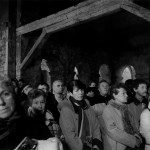
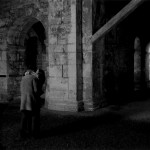

Statements zu geben ist nicht meine Sache, meine Bilder sprechen für mich und für sich.
It is not my task to make statements, my photographs speak for me and for themselves.
—Barbara Klemm
∞
Asked to write about John Cage:
Just a
wOrd about
How
fiNe it is
he feels still to be here
—Alison Knowles
∞
Back in 1969, in my appreciation of Inferential Art, which was my coinage for what became known as Conceptual Art, I conjectured that the visual equivalent of John Cage’s 4’33″ would be framed clear material; so in his memory, some four decades later, I realized it.
—Richard Kostelanetz
∞
Not Wanting to Say Anything about John Cage
My association with John Cage was often contradictory. But then, something lively always includes contradictions. Relationships without contradictions often signal a moribund state.
When Luigi Nono arrived in Prague in 1960 and gave me a booklet that contained transcripts of lectures from Dartmstadt from the summer of 1959, he surely did not expect that it would spark my interest in Cage. At that time, it was Nono, Boulez, Stockhausen and other Darmstadt associates that interested me. I had no idea about music beyond what was coming out of Darmstadt. The booklet Darmstädter Beiträge Nono gave me contained ideas and concepts by Cage, Edgar Varèse and Christian Wolff and instantly, their writings became much more interesting to me than what the European composers were doing. It must have been a few months later that I heard Cage’s music for the first time – the recording of the Concert for Piano and Orchestra from the 1958 Town Hall concert. I was utterly confused, but my puzzlement and confusion only increased the attraction of the music, especially when I witnessed the strong negative reactions by my colleagues in Prague. To the irritation of musicians around me, I was increasingly drawn to Cage, intuitively, disregarding my likes and dislikes and doing it with pleasure.
In the spring of 1964, while I was studying in Vienna, Friedrich Cerha called me to ask whether I would perform with Cage who was about to arrive. I had no idea what was needed and expected to perform as part of an ensemble. “Just come to the Museum of the 20th Century in the Schweizergarten,” Cerha told me over the telephone. That morning, Cage and Tudor were already at the Museum. I brought my flute and piccolo, but didn’t need them at all. Cage asked us, including Cerha, to perform as percussionists. We were part of Merce Cunningham Dance Company’s “Event No. 1,” playing Cage’s “Atlas Eclipticalis” – six percussion parts for the duration of three hours. The rehearsal took roughly nine minutes. Cage disliked rehearsing. Observing his performances, one almost had a feeling of a measured distance between him and the music. He had no use for the physicality of performance, displayed so brilliantly by David Tudor. Cage tried to avoid working in a collective, especially in a situation that called for an individual to direct the group. His idea of musical preparation was individualistic; everyone was expected to work on his or her own, without the “interference” of someone telling them what to do. That of course contradicts the idea (and practice) of performing music with a large-scale ensemble, including and especially with an orchestra.
One of my most important experiences with Cage was the scandalous performance of his Song Books No. I, II at the “June in Buffalo” festival in 1975 at the University of Buffalo. Julius Eastman, one of the members of the S.E.M. Ensemble at the time, either misunderstood or sabotaged the piece, and as there were no rehearsals (according to Cage’s instructions), it was discovered only during the performance. Cage erupted angrily, and the way he voiced his criticism must have been the strongest to date, as he pounded with a fist on a piano lid during the next day’s discussion of the event. This “crisis” helped me tremendously. I came to an understanding about the responsibilities of a performer, especially the one who is “in charge.” I didn’t give up, and we had exemplary performances of Song Books more than five years later in New York and Europe. This time, Cage participated in the rehearsals.
When I lived in Buffalo and traveled frequently to New York City, Cage and I met very often. My visits to the city were enough of a reason to get together. When I moved to New York City in the early 1980s, my visits with Cage were less frequent. We could see each other any time, so there was no reason to rush to 18th Street to say hello. My last visit with Cage was about one week before he died. He tried to identify some of the people to whom he dedicated each of the 86 parts of “Atlas Eclipticalis.” (I was preparing for the first complete 2-hour performance of “Atlas” at Carnegie Hall.) He found it amusing that so many of the dedicatees were already dead. Not long afterward, to the sadness and shock of us all, he joined those who were no longer with us.
—Petr Kotík (Ostrava, Czech Republic, January 4, 2012)
∞
“With all the chaos in the world, why do you create more?” were the first words I ever spoke to John Cage. “Perhaps when you go back out into the world, it won’t seem so chaotic anymore.” Was the reply he gave, after searching me out in the crowded Berlin Philharmonie in 1972, during a particularly disturbing performance of HPSCHD. John Cage became my mentor and my friend, countering my questions with new questions, to elicit the knowledge that was already inside me. He encouraged my explorations, showing by example how to stand up to adversity. In the two decades that we worked together, I saw him respond to many situations with care, patience and generosity, and I performed his music in circumstances that were sublime and devastating. His lasting effect on my own music lies in problem solving: layering disparate elements in ways that defy logic but provide surprising results; I rely on this methodology in my compositional process. And he is always hovering at my right shoulder, beaming beatifically as he did in his first words to me.
—Joan La Barbara
∞
Proposal for the making of a statement on, about and related to John Cage, according to three possible figures of thought extrapolated from his work:
1. Acoustics Multiplied
2. The Supplement
3. Difference-Making
—Brandon LaBelle
∞
My life is defined as “AC/BC”…. After Cage/Before Cage.
—Margaret Leng Tan
∞
A Dictionary Definition of Music minus j,o,h,n,c,a,g, and e:
1 : t__ s_i____ _r _r_ _f _rd_ri_g t___s _r s_u__s i_ su___ssi__, i_ __mbi__ti__, __d i_ t_mp_r_l r_l_ti__s_ips t_ pr_du__ _ __mp_siti__ h_vi_g u_ity __d c__ti_uity
2 : v___l, i_strum__t_l, __ m_____ic_l s_u_ds __vi_g r_yt_m, m_l_dy, __ __rm__y
—Alan Licht
∞
John encouraged me to pursue the idea of using brain waves in a musical composition while I was teaching at Brandeis University in Massachusetts. I had doubts about the piece. (Cage would most often say yes rather than no to any new idea.) I am grateful to his support.
—Alvin Lucier
∞
John Cage told me once that he liked to listen to car alarms when they woke him up at night. He said that if you focused on their sounds for long enough they would become interesting and eventually put you back to sleep. This was in the early 80′s when car alarms were a real nuisance in New York City.
—Christian Marclay
∞
Dear John,
I never met you but I think that we could have had a lot of fun together.
Silence is supposed to be your thing but actually its all about hearing.
I am going to make you a birthday cake for your birthday but what it actually looks like and how it sounds must be kept secret until the celebration at MQ in Vienna in February.
I am experimenting and will let you know when I am there…
The bakers are not cooperating as I expected either.
I may have to bake this one myself.
And then there’s the “sound” part.
Because that’s what its all about, our “metier” so to speak.
Flour and circuit boards don’t exactly mix, neither do magnets and candles.
I hope you understand the dilemma.
Whatever happens I trust you will be proud of me.
Your
—Benoît Maubrey
∞
Cage’s work is the making of a space in which we might reside, and then make our own.
—Jeremy Millar
∞
When I was a teenager in the early 1970s, a friend of mine told me about John Cage and his ‘silent piece’. I naïvely responded that I thought it was a silly idea, since playing a record of it would only produce the noise of surface scratches. Several years later, in 1978, I was attending the final class of a two-year-long course in music history, and my professor devoted that final class to covering the entire history of twentieth-century music, which he considered appalling, but he was obliged to teach it in order to satisfy the university’s curriculum. At one point he mentioned Cage, whom he laughed at, saying something like “he claims to be a composer” and that he once “composed” a piece that was silent. I was fascinated and stunned at the same time, and I recalled my friend trying to explain this to me years before. Immediately after that class, I went to the music library and checked out Cage’s books: “Silence”, “A Year From Monday”, and “M. I” spent the next several days reading these books, and during that time I conceived my first piece of sound art, for three reel-to-reel tape recorders. Needless to say, discovering Cage instantly changed the direction of my life.
—Gordon Monahan, January 2012
∞
Here are the 3 sentences on John Cage:
John Cage
O n age
H a!
—Charlie Morrow
∞
I read Silence and A Year from Monday in college, hardly realizing then the power of the potion I was absorbing. It was the early ’80s and often, while playing at Phill Niblock’s Experimental Intermedia, we heard a high, infectious giggle at special musical moments – it was John Cage laughing with pleasure. Years later, John said to me, “you remind me of Demetrio Stratos”, and I laughed in pleasure with him.
—David Moss
∞
I met John Cage when I was a twenty year old art student and his thinking and writings and music have influenced me for a half century. In honour of his 100th birthday I have been working on a series of drawings which bring to the forefront his inscrutable ability to question everything. One hundred drawings of the ear, universal symbol as well as instrument for listening, are matched with questions from Cage’s seminal book Silence, published in 1961, the year in which I met him.
—Morgan O’Hara
∞
Složil ticho, pokazil několik klavírů a sbíral houby.
He composed a silence, spoilt few pianos, and collected mushrooms.
—Marian Palla
∞
John Cage has returned sound to music and music to sound.
—Paul Panhuysen, January 2012
∞
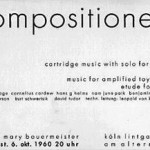
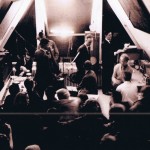
I first met John Cage at Mary Bauermeister’s Atelier in Cologne, Germany in early June 1960.
This meeting changed my life forever.
In the 1970’s I enjoyed many Saturday night poker games with John and others at the Gate Hill Coop, Stony Point, New York.
These evenings changed my life forever.
In the early 1980’s I witnessed John at a rehearsal of the Westchester (New York) Symphony.
This experience changed my life forever.
—Ben Patterson
∞
Like John Cage, I first became interested in fungi through an interest in collecting edible mushrooms. They seemed maddeningly unpredictable, sometimes appearing in profusion, yet often not to be found in seemingly suitable conditions. It is only the sudden manifestation of these fruiting bodies that alerts us to the presence of the mycelium, the body of the fungus, which may have been growing for years, unseen and unsuspected. In order to fruit, the mycelium must have enjoyed reasonable growing conditions, adequate amounts of water and nutrients. It must have built up a certain store of energy. However, it will usually only begin to produce fruiting bodies when it undergoes a certain amount of stress, such as that produced by the changing seasons.
Cage drew inspiration from the unpredictable fruiting of mushrooms in formulating his key concept of Indeterminacy. A composition could be likened to the fruiting of a given species of mushroom in a given habitat. The species of mushroom and the habitat could be defined, but the actual numbers and locations of fruiting bodies would always be indeterminate and surprising. Cage experimented with many methods of incorporating indeterminacy in his compositions, including using the I-ching to determine parameters of the composition, graphic scores, and unpredictable electronics. His collaborations with Merce Cunningham were another example, the music and the choreography were produced separately, with results that were unpredictable and surprising when they were finally combined.
“That we have no ears to hear the music the spores shot off from Basidia make obliges us to busy ourselves microphonically.” —John Cage
In my own work, I have used fungi as an actual source of sounds for my compositions. All living organisms produce a faint electrical current, which constantly fluctuates according to the state of the organism. This current can be amplified and used as a control signal for an oscillator, producing a sound which directly reflects the state of the organism. A mushroom still connected to a growing mycelium produces a varied and interesting rhythm, while a mushroom that has been picked produces only a static tone. It is possible to listen in to the life force of the fungus. For Agarikon, I have used the I-ching to determine the choice of images, the sequence and duration of each segment. Further Indeterminacy is created by the interaction of the four soundtracks which are switched on and off in response to the movement of people in the room. The soundtracks are all of different lengths which loop endlessly,so the combination of sounds are always changing.
—Michael Prime
∞
What stays with me about knowing John Cage was the way he lived his life and art effortlessly, with a certain grace, spontaneous joy, and generous humor. He showed how work can be self-true in the way it fits the moment and the place, following one’s own rhythm that is singular yet openly responsive. He altered people’s listening and thinking (changing the world without making matters worse) just by being and speaking as himself.
—George Quasha
∞
CAGED THOUGHTS
I remember John talking about how he didn’t like to listen to a record more than once. What was the point? If one gave oneself over to the experience the first time, then why repeat? He didn’t really care for the idea of music as ‘fixed in time’ on a black platter. He said he’d rather open the window and listen to the trucks rolling by, or whatever else was coming in-the constantly changing music of NOW rather than a packaged simulacra of ‘then’. Of course that’s the real idea behind 4’33″–it’s not a silent piece at all-there is always sound! Those comments have long stayed with me, in spite of the fact that I love both making records and playing records-often the same ones over and over again.
In 1982 I performed with Glenn Branca’s large ensemble at New Music America in Chicago. Cage was also in Chicago that year. I’m not sure if it was the first time John had heard Glenn’s music or not, but after seeing our performance he made some comments to the effect that it was a form of ‘musical fascism’ (with Glenn as all-powerful conductor pulling this music out of his ensemble), and for that he felt uneasy, uncomfortable with it. His comments caused quite a little stir at the time, perhaps more so than he intended, but it’s clear that his interest was in trying to move music in a different direction, away from the dominance of the composer/conductor and towards a much more ‘Zen’ or ‘landscape’ approach to sound creation and presentation, much closer to the unorchestrated randomness of the trucks rolling by outside his windows…
My friend, the Portuguese composer Rafael Toral, once told me his story of being a young composer, back in 1992, and writing to Cage to request permission to stage a piece of his in Lisbon. This was in the days before email (I don’t know if John ever used email) and he sent his letter off to John and Merce’s Westbeth address. Some time passed and he heard nothing, and then that summer it was announced that Cage had died. As well as sorrow for the death of the great composer, my friend felt a sadness at not having been granted permission to go ahead with his version of John’s piece. He assumed he’d have to forgo the idea. However, a week or so later, a letter came in the mail. John had written him, giving his approval. Somehow that story always reminds me of the often-surprising nature of John’s music
—Lee Ranaldo, New York City January 2012
Quite a while ago I’ve heard about the possibilities of some kind of fungi being able to move, in search for goodies, with a simple kind of ‘brain’ / ….
and on top of that they can move back and front between a singlecellular and a multicellular stage..
That’s my symbol of freedom for John..
“Fungi will always walk the Water Walk”
- Welcome the Myxomycetes -
http://blog.wildyorkshire.co.uk/tag/myxomycetes/
http://en.wikipedia.org/wiki/Slime_mould
—Zeger Reyers, 8 Jan. 2012 – The Hague, NL
∞
Encountering Cage back in ’82 where we (AMM) performed at his birthday celebrations in London, I was impressed by his encouragement and support for what we were doing, extraordinarily kind and generous, we talked about the use of the radio, he was encouragingly open as to the differing approaches, for the most part his influence came through Cardew and Tudor, the ’61 recording of Variations II (Cage/Tudor) became most influential.
I’ve come to feel that one of the most important aspects of ones life is to inspire others to make their work, John certainly achieved that.
—Keith Rowe, January 4, 2012
∞
Johna Cage jsem měl trochu jako emblematickou figuru pro své hrátky s hudebním diletantismem.
Z jeho experimentování na mne dýchala vstřícná otevřenost a radost.
—Blahoslav Rozbořil
∞
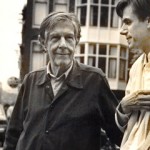 JOHN CAGE — FROM ZERO
JOHN CAGE — FROM ZERO
Marina Abramovic, the well-known performance artist, mentioned the name of John Cage to me. She thought it would be important for me to get in touch with his mind. I met him at a rehearsal with the Merce Cunningham Dance Company during the Holland Festival in June 1982. I was still studying at the Film academy in Amsterdam at that time. At that moment I wasn’t really aware of how important he was. I introduced myself and told him that it was Marina’s idea that I should talk to him. I mentioned the fact that I didn’t know anything about his work except that he was a composer. He granted me an interview that lasted for about one hour. Afterwards he told me that he loved doing it because it was a conversation without any preconceptions from my side. I must admit that I had understood very little of what he had told me. At the end of the interview he saw the dancers leaving and he asked me if I had any more questions for him. I replied: “Do you have anything more to say.” He laughed and said: “The next time we meet they will come up.” After analyzing the interview and studying more about John Cage’s way of thinking I realized that it was probably the most influential meeting in my young artistic life so far. He had freed of a lot of my past associations. Or to put in his own words: “He got me out of the cage.”
—Frank Scheffer
∞
Snaha o co největší omezování mých vstupů a autorského vlivu při vzniku díla spolu s přiznáním náhody jako rovnocenného partnera – tak by bylo možné shrnout ovlivnění mé tvorby myšlenkovými postupy a přístupy skladatele Johna Cage. Jedině tak mohly vzniknout ve druhé polovině 80. let i mé fotografie záznamů přehrávání skladeb Johna Cage.
—Jiří Šigut
∞
Určení plochy jedním bodem je zdá se mi vždy přesné. Druhým bodem začíná problém. Cage.
—Jan Steklík
∞
In high school, I came across Cage’s silent piece, and I thought music was over. Later, I read his “Lecture on nothing.” There he says, “I have nothing to say and I am saying it and that is poetry as I need it,” and I thought art had just begun.
—Volker Straebel
∞
John Cage is my main man!
—Richard Teitelbaum
∞
John’s disciplined ears weren’t lazy at all.
—The Lazy Anarchists
∞
Not Wanting to Talk About Either Marcel or John.
—Yasunao Tone
∞
De teerling is geworpen!
The world for one moment in the hands of rolling dice.
—Kris Vleeschouwer
∞
What I am exploring now on daily basis is if living and working are the same thing. One thing for sure — it’s all a learning process.
—Hong-Kai Wang
∞
What can I still say about John Cage?
I love his work, all of it, as I always have, and himself. But feel no need to further it, as, long ago, along with others, I talked and wrote about it, introduced it to people, and performed it. Now it doesn’t need that from me (but I still enjoy performing it). Others – in quite large numbers – have taken over those activities.
Though I don’t feel it that way, I know that for a long time, and still, I’m regarded by some as in his shadow, that youngest member of the New York cohort (Cage, Feldman, Brown), who now happens to be the sole survivor. (The cohort should include David Tudor, as, in the early years, the performer for whom we wrote and because of whom we wrote much of what we did write; and the dancer and choreographer Merce Cunningham, in whose work we could take in something visual and physical, which our music might be together with, or counterpoint.)
I don’t want to repeat stories (quite a few) I’ve told elsewhere.
Alright, I will say this much: the important qualities he represented:
experiment — keep trying new things, change, extend your invention;
discipline — a form of letting go of the self, working systematically and hard;
attentiveness – regard everything alertly, use your intelligence;
make music as your life in the world, which also entails thinking about and (in ways you find possible) acting socially and politically in a principled way (he’d say, act with conscience);
comedy, not tragedy;
listen to everything — in his music the wonderful empty spaces, and the extreme quantities of sound and activity layers;
elegance.
JOHN CAGE NOTE(S)
—Christian Wolff, December 26, 2011
∞
Zwei von mir sehr verehrte Komponisten. Bach ist groß und blockhaft wie Pindar. Cage bewundere ich wegen des Muts und der Freude am Experimentieren. (Das habe ich mit Letzterem gemeinsam.)
Two composers I deeply revere. Bach is large and blocky, like Pindar. I admire Cage for his courage and the pleasure he takes in experimentation. (I share this with the latter.)
—Gerlinde Wurth
(63)
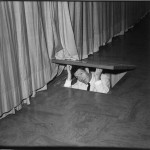
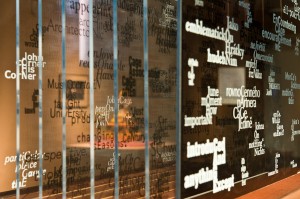
Leave your comment
You must be logged in to post a comment.